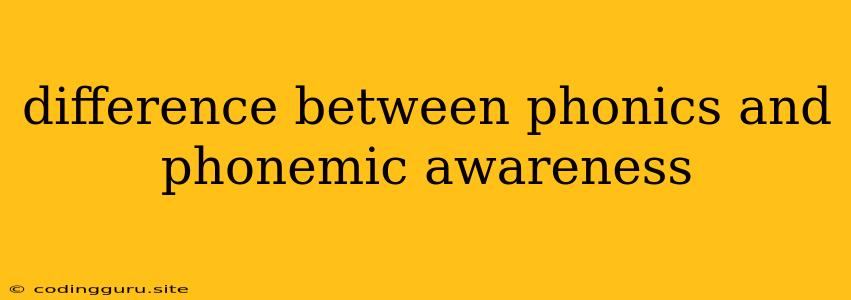The Difference Between Phonics and Phonemic Awareness
Often used interchangeably, phonics and phonemic awareness are two distinct yet interconnected skills that play a crucial role in reading development. While both focus on the sounds of language, they differ in their approach and ultimate goal.
What is Phonics?
Phonics is a method of teaching reading that focuses on the relationship between letters and sounds. It teaches students to decode words by understanding the sounds each letter or letter combination represents.
How does Phonics work?
- Explicit Instruction: Students are directly taught the sounds of letters and letter combinations.
- Decoding: Students use their knowledge of letter-sound correspondence to sound out unfamiliar words.
- Practice: Students engage in activities that reinforce their understanding of letter-sound relationships, like reading decodable texts, writing words, and playing phonics games.
Examples of Phonics Activities:
- Sound Sorting: Students sort pictures or words based on their initial sound.
- Blending Sounds: Students combine individual sounds to create words (e.g., /c/ /a/ /t/ = "cat").
- Segmenting Sounds: Students break down words into individual sounds (e.g., "cat" = /c/ /a/ /t/).
What is Phonemic Awareness?
Phonemic awareness refers to the ability to hear, identify, and manipulate the individual sounds in spoken words. It is a foundational skill for reading because it helps students understand the building blocks of words.
How does Phonemic Awareness work?
- Oral Language: Students focus on the sounds of spoken language, not written letters.
- Manipulation: Students engage in activities that involve manipulating sounds in words, like isolating sounds, deleting sounds, adding sounds, and substituting sounds.
- Development: Phonemic awareness skills develop gradually over time, starting with the ability to hear rhymes and ending with the ability to manipulate individual sounds.
Examples of Phonemic Awareness Activities:
- Rhyming: Students identify words that rhyme (e.g., cat, hat, bat).
- Initial Sound Identification: Students identify the first sound in a word (e.g., "What is the first sound you hear in 'dog'?").
- Sound Deletion: Students say a word, delete a sound, and say the resulting word (e.g., "Say 'train' without the /t/ sound").
The Relationship Between Phonics and Phonemic Awareness
Phonemic awareness provides the foundation for phonics. It helps students understand that words are made up of individual sounds, which they can then learn to connect with letters. Phonics then builds upon this understanding, teaching students how to use their knowledge of letter-sound relationships to decode words.
Why are Both Important?
- Reading Success: Strong phonemic awareness and phonics skills are essential for reading fluency and comprehension.
- Early Intervention: Children who struggle with phonemic awareness are at risk for reading difficulties. Early intervention with phonemic awareness activities can help to prevent these difficulties.
- Lifelong Learning: These skills are crucial not only for reading but also for spelling, writing, and language development.
Key Takeaways:
- Phonemic awareness focuses on understanding the sounds of spoken language, while phonics focuses on the relationship between letters and sounds.
- Phonemic awareness is a foundational skill for phonics, as it helps students understand the building blocks of words.
- Strong phonemic awareness and phonics skills are essential for reading success and lifelong learning.
In conclusion, while phonics and phonemic awareness are distinct skills, they work together to help children become proficient readers. By understanding the difference between these two concepts, educators can create effective reading instruction that supports the development of both skills.
